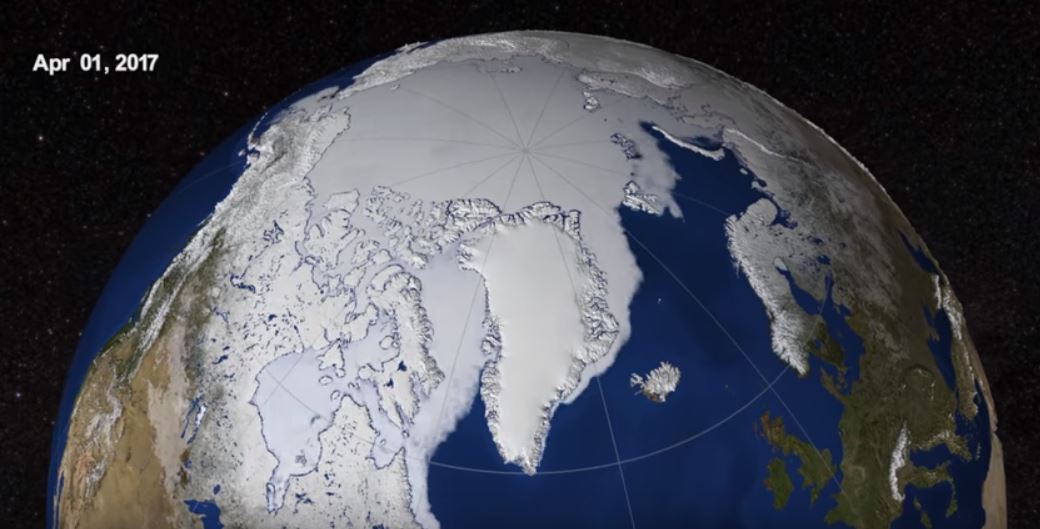This story about melting in the Arctic was first published by CleanTechnica
Last week, the National Oceanic and Atmospheric Administration issued its annual report. The document has a rather interesting subtitle — “Arctic shows no sign of returning to reliably frozen region of recent past decades.” That’s right, folks. The Arctic, the frozen wasteland that fascinated intrepid explorers like Amundsen, Peary, and Nansen, is no more and won’t return to its former state in your lifetime, or your children’s lifetime — or their children’s lifetime, for that matter. NOAA has a new name for the area at the top of the world. It calls it “New Arctic.”
But it’s all good. The loss of sea ice will make drilling for fossil fuels easier and less expensive, fattening the profits of oil companies and leading to even more carbon emissions. The competition among nations to exploit this long buried hydrocarbon wealth will likely lead to armed conflicts, similarly boosting the profits of armaments manufacturers. Either way, the Trumpian notion of raping the earth to create jobs and deliver more wealth to the wealthy will be the real winner from all this melting.
Timothy Gallaudet, the acting administrator of NOAA, told the press the changes observed in the Arctic will have a “huge impact” on everything from tourism to fisheries to worldwide weather patterns, according to Salon. “What happens in the Arctic doesn’t stay in the Arctic — it affects the rest of the planet,” he said.
Speaking to NPR, Jeremy Mathis, a marine scientist and director of NOAA’s Arctic Program, said “there is no normal” anymore. “The environment is changing so quickly in such a short amount of time that we can’t quite get a handle on what this new state is going to look like. The rate of change is unprecedented in at least the last 1,500 years and probably going back even further than that. Not only are we seeing big changes, we’re seeing the pace of that change begin to increase.”
Using data from lake sediment, ice cores, and tree rings dating back as much as 1,500 years, NOAA says the pace of change in the Arctic is unlike anything the region has experienced in millennia. And what will all this thawing mean for the world? Vladimir Romanovsky, a scientist at the University of Alaska in Fairbanks who studies permafrost, claims that melting of the permafrost will release large quantities of stored carbon dioxide into the atmosphere. That will compound the problem of global warming throughout the northern hemisphere.
The knock-on effects that flow from the disappearance of sea ice in the Arctic are already leading to a longer growing season, greening of the tundra, a sharp rise in the number of wildfires, and a spike in plankton growth. These changes are self-reinforcing, meaning they promote more warming, more melting, and more changes in the environment.
“We’re fairly confident now,” Mathis said, that warmer temperatures in the Arctic are “creating conditions where more extreme weather events are beginning to show up in North America.” New research published earlier this month suggests a strong link between Arctic sea ice melting and the drought affecting parts of California, a drought that has contributed to the devastating wildfires near Los Angeles this month (which even took down the home of one of CleanTechnica‘s own).
Gallaudet tells Salon he delivered the report personally to the White House last month and that Trump administration officials are “addressing it, and acknowledging it, and factoring it into their agenda.” That may remind some of you of the ending to the movie Raiders Of The Lost Ark, where the ark is consigned to a government warehouse to be buried amongst thousands of other artifacts and forgotten about.
Eric Holthaus, the author of the Salon story, closes with some well chosen words. “That the Arctic is now a relic of a time gone by — the first major part of the planet on a countdown clock — should shock us. It’s one of those facts that those of us who closely follow climate change knew was coming. And with its arrival, it is devastating in its totality.
“The loss of the Old Arctic is as close as humanity has come so far to irreversibly transforming its planet into something fundamentally different than what has given rise to civilization over the past 10,000 years. This is a terrifying transition, and one worth mourning. But it’s also a reminder that our path as individuals and as a society is not fixed. If the Arctic can change this quickly, then so must we.”
But will we? Based on the observable evidence, the one country that should be taking a leadership role is instead consumed by partisan bickering, wedding cakes, emails, and other ephemera that don’t amount to a pisshole in the snow. The idea that the Trump administration is “factoring [the NOAA report] into its agenda,” may be the most terrifying news of all.
